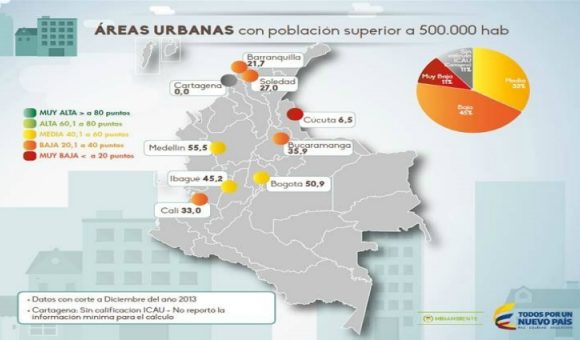EPM Avoids Catastrophe at Hidroituango Hydropower Project

Medellin-based multinational electric power giant EPM announced 12 pm Thursday, May 24 that it finally reached a crucial safety milestone toward eventual completion of its under-construction, 2.4-gigawatt “Hidroituango” hydroelectric dam on the Cauca River, which had been threatened with possible collapse.
Over the past three weeks, EPM hurriedly scrambled to raise the dam height to at least 410 meters above-sea-level – a height that enables excess Cauca River water to flow safely through an engineered spillway near the top, at 401 meters above sea level, or nine meters below the dam height. The spillway hence avoids water overtopping the dam, which could have caused disaster.
Now, over the next few weeks, EPM will continue raising the dam height, to at least 415 meters, and will move to close two existing water-diversion tunnels, hence enabling repair work to the mechanical room, damaged during a tunnel-blockage emergency, according to the company.
In recent weeks, excess water flowing on the Cauca has been diverted through engineered diversion tunnels as well as the under-construction mechanical room, all of which are located far below the dam.
However, two out of three of the diversion tunnels had been blocked by rocks and dirt (and possibly logs) — either occasionally or permanently over the past three weeks — coincidentally during exceptionally heavy rains in April and May. Unfortunately, the third alternative diversion tunnel had already been cemented-in, in anticipation of a normal, scheduled evolution of the construction project.
A previously undetected geological fault near the main diversion tunnel might have been exposed to surging Cauca River waters over the past weeks, triggering partial tunnel collapses and Cauca water escape-route blockages, EPM officials said.
Suddenly, on May 13, a temporary blockage in the main diversion tunnel burst free, sending millions of gallons of floodwaters downstream, overflowing banks at the town of Puerto Valdivia, causing damage to several dozen homes and a passenger bridge.
That same diversion tunnel still potentially could suddenly unplug in coming days, causing another, temporary flood surge around Puerto Valdivia — even after the dam spillway is completed, EPM warned.
Fortunately, EPM already set-up an elaborate earning-warning system, alerting residents downstream of the dam well in advance of any possible flood. Thanks to that system, vulnerable populations had long since moved to safer, higher ground, so no-one was killed or injured in the May 13 incident.
That one-time flood incident and the potential threat of a future dam collapse also had forced nearly 24,000 people — including some 3,300 in the town of Puerto Valdivia — to flee to higher ground, where they’ve been living for more than a week now, awaiting cancellation of flood threats.
As a result of the completion of the dam spillway system, only the 3,300 residents of Puerto Valdivia will have to remain in higher-ground shelters for the time being, EPM added today.
Despite the typical inconveniences of temporary displacement, at least the evacuees are receiving free food, water, shelter, beds and medical care, all paid-for and organized by EPM. EPM also will pay-for reconstruction of damaged or destroyed homes as well as related infrastructure.
Still, by averting a dam collapse, EPM avoided a disaster that could have wiped-out everything alongside its path for many miles downstream, threatening homes and lives of as many as 200,000 people.
When the main diversion tunnel plugged 10 days ago, EPM temporarily re-routed the Cauca river overflow through the under-construction mechanical room, providing a safe water escape pathway until the dam-raising construction would reach at least 410 meters.
While this temporary diversion helped avoid a catastrophe, it also has caused as-yet-unspecified damage to the mechanical room. Still, EPM managed to rescue some expensive equipment prior to the re-routing through the mechanical room.
Besides physical damage to the mechanical room, the flooding and blockage incident also will push-back start-up of the first 300-megawatts (MW) of the 2.4-gigawatt hydropower project beyond the initially targeted December 2018 start-up, according to EPM.
Despite these disappointments, Colombia’s national association of power producers (ALCOGEN) issued a bulletin May 10 advising that Colombia won’t be lacking power capacity for at least the next three years — even if Hidroituango’s start-up is delayed by months or even years (although the latter delay now is seen less likely).
EPM also revealed that it has insurance coverage to help pay for the damage to the mechanical room and related infrastructure, as well as loss-of-income from a likely delay in power sales from Hidroituango.
Aside from relatively minor injuries to five EPM workers during the crisis, no downstream citizens were killed or injured by the temporary surges in Cauca water levels — thanks to EPM’s well-organized alert-and-rescue operations during the crisis, involving numerous government agencies.
















